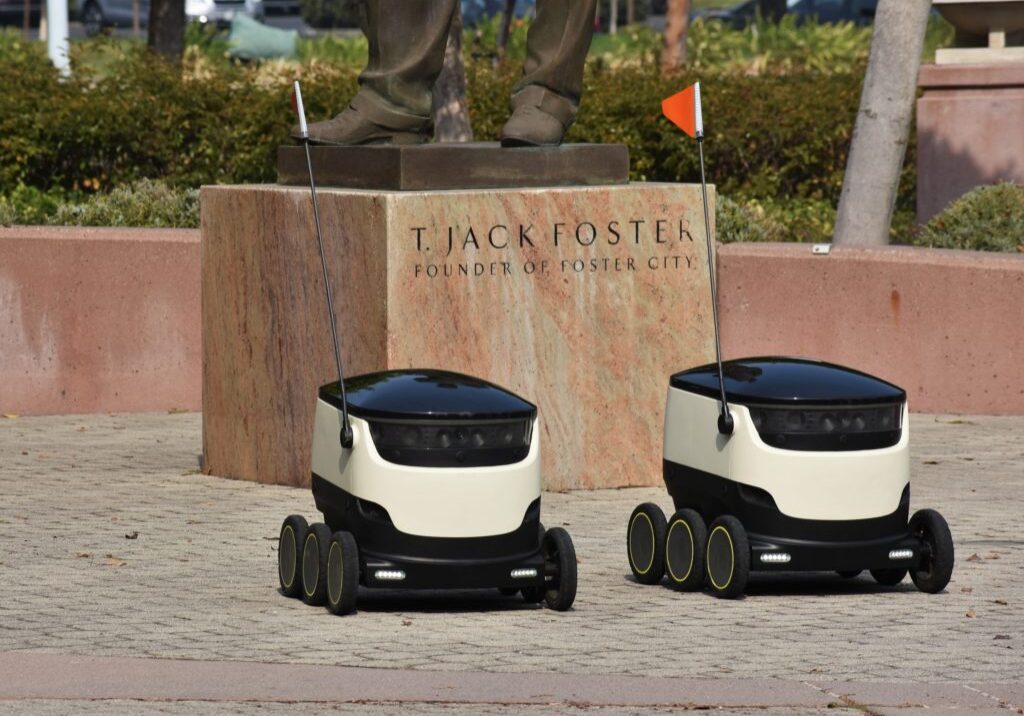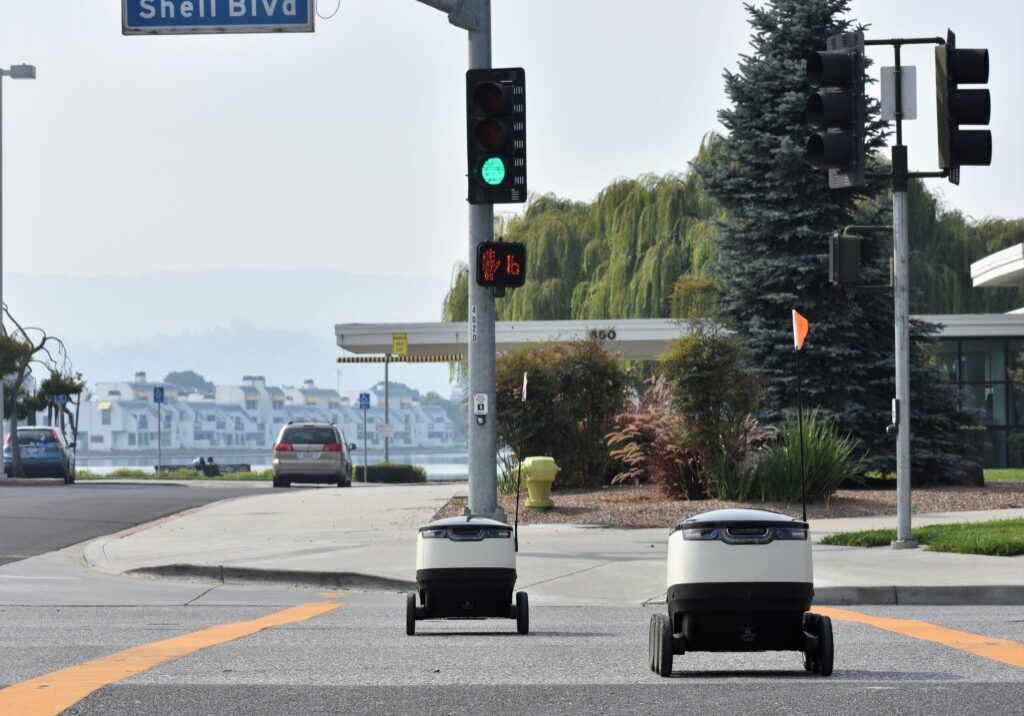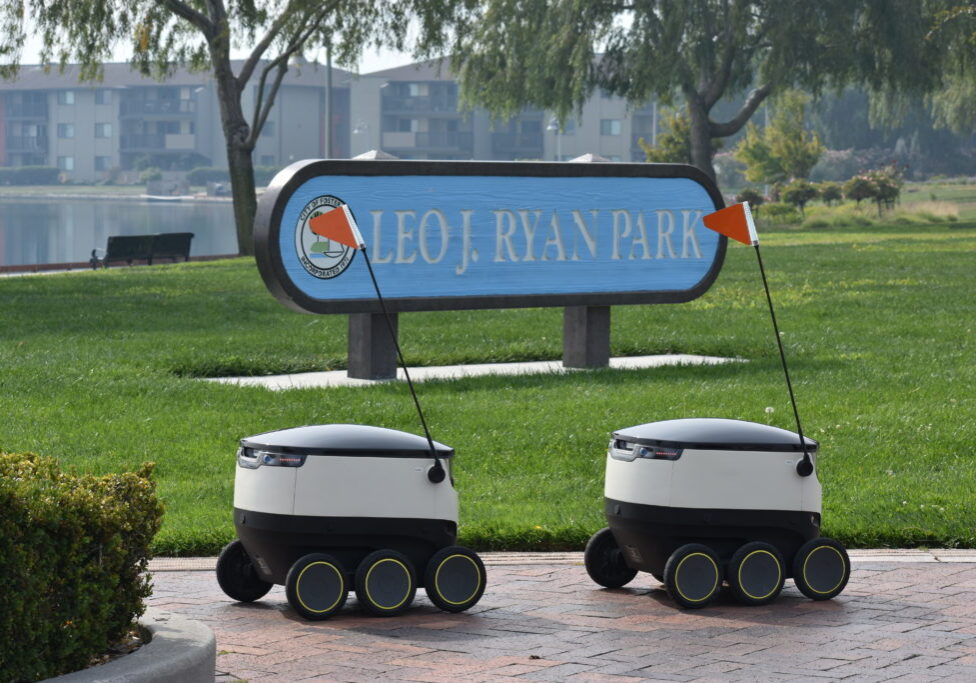
autonomous robots
The City of Foster City approved a pilot program to allow the use of autonomous robots, also known as Personal Delivery Devices (PDD). The City will permit Starship Technologies, Inc. to use their robots on City sidewalks and streets, delivering goods such as restaurant meals and groceries to residents and businesses.



Starship Technologies Personal Delivery Devices visiting Foster City
Frequently Asked Questions
How much does it weigh?
The robot weighs 20kg/45lbs empty and the delivery compartment can hold up to 10kg.
How fast does it go?
The robot can drive up to 10 mph / 16 km/h but initially we are limiting the speed to 4 mph / 6 km/h
Does it drive on roads or sidewalks?
The robot can drive anywhere a pedestrian can walk but mainly sidewalks.
Why on sidewalks?
The robot acts like a pedestrian. It merges with pedestrians, it matches pedestrian speeds. The only place for the robot is on the sidewalks. It is much safer.
How much can it carry?
This current model carries up to 10kgs/20lbs, or 3 shopping bags
How does the robot know how to drive autonomously?
The robot uses a mixture of GPS and Computer vision to pin point its exact location to the nearest inch. Starship uses proprietary mapping techniques to ensure accuracy.
How does the robot avoid hitting things?
The robot has obstacle detection. It has a ‘situational awareness bubble’ around it. It uses its 9 cameras and ultrasonic sensors to detect obstacles, whether it be a dog or a pedestrian/cyclist. The robot will always stop at a safe distance.
What does it deliver?
Essentially anything up to 10kg that can fit inside its delivery container such as parcels, groceries and food.
Where does it deliver?
The robot is designed to deliver goods on the last mile of the delivery journey – within suburban, residential areas. It can deliver within a 2 mile radius.
How does the delivery process work?
You would order something online like normal. Starship delivery would be offered in the check-out area of the website. You would then be notified on your mobile that your package/groceries/food were ready for (this means the retailer/supermarket/restaurant has placed the item into the robot). The power now lies with the consumer. They can call the delivery at any time convenient to themselves (before work, after work or the middle of the night). Once the robot turns up at your door, you can press the ‘Unlock’ button through your mobile application. The lid unlocks and you take your item.
How safe/secure is the robot?
The cargo hold remains locked until the robot reaches the customer and unlocks it through their mobile phone. The robot has 9 cameras that are recording, two-way audio so Starship can engage with people around the robot, sirens if picked up or tampered with, and tracking to the nearest inch.
Has anyone tried to steal the robot yet?
The robot has traveled tens of thousands of miles and come into contact with millions of people. So far, no one has tried to steal the robot. Of course in the future, when there are thousands of robots in thousands of cities, it is impossible to prevent. Just like some people steal cars and bikes. However, Starship do have many theft prevention measures in place to stop it from happening. Sirens if you pick it up, tracking to the nearest inch, the lid is locked, you don’t know what’s inside it, cameras, 2-way audio to name a few. It’s an embarrassing thing to get caught stealing.
What happens if the robot breaks down?
The robot will come to a safe stop. As the robot only goes 4mph, it can come to a safe stop very quickly without causing any surprise or harm to anyone in its surroundings. A member of the Starship team will then come and collect the robot if this was to happen on a rare occasion.
How will the robot cross the road?
In the short term, the robot will only cross the road by a human operator for safety reasons. As the % of autonomous driving increases, the robots will slowly start being able to cross the roads themselves. In the long run, when driving 99% autonomously, the robots will only call on human assistance when the road crossing is particularly busy or difficult.
Will this mean the end of the delivery driver?
Definitely not. Delivery drivers are still the most efficient method for the first 10-100 miles of the transportation process. Delivery drivers will work closely with our robots to ensure the entire delivery process becomes more efficient. We may even have delivery drivers picking up and dropping off robots in different neighborhoods.
Will the robots cause a loss of jobs?
No, Starship thinks you will actually see a creation of jobs. Last mile delivery is the largest bottleneck in growth of the e-commerce industry, especially local e-commerce such as groceries and food delivery. By removing this, we will provide a new lease of life to retailers, and therefore increasing deliveries from warehouses using trucks and vans.
What is Starship Technologies?
Starship has built the world’s leading semi-autonomous delivery robot. The robots are designed to manage local delivery of packages, groceries and food. The robots will deliver up to 10kgs/20lbs worth (three shopping bags) within 15-45 minutes, to homes within a 2-mile radius. In the future, Starship aims to bring the cost of delivery down to as little as £1. The robots can be requested by the consumer completely ‘on-demand’ through their mobile phone. The robots will at any time of the day.
Who’s behind Starship Technologies?
Starship Technologies was launched by Skype co-founders Ahti Heinla and Janus Friis in 2014. The company’s CEO is Ahti Heinla and Allan Martinson is the COO. You can learn more about Starship Technologies at their website.